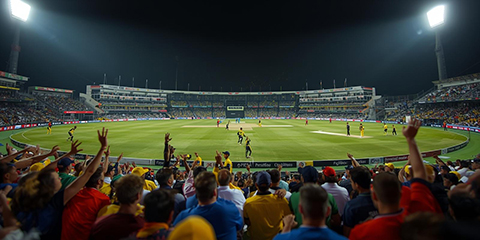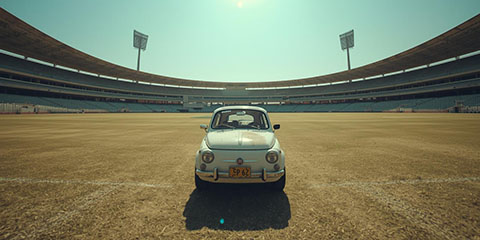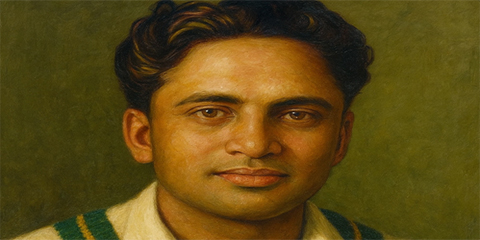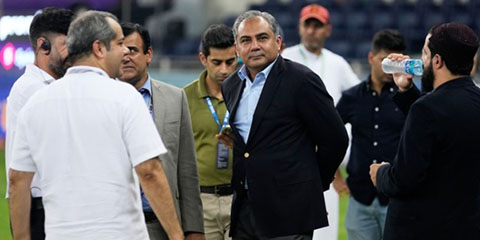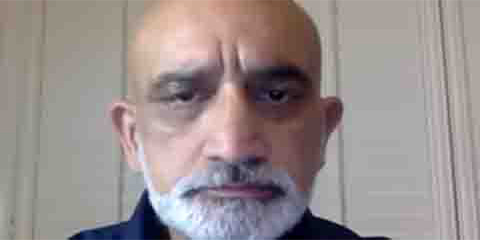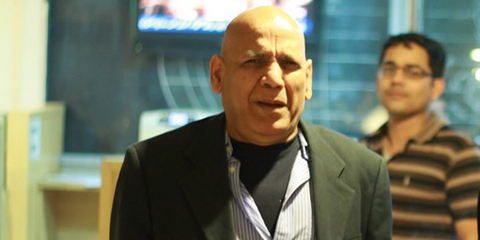Collector preserves Pakistan cricket history in rare memorabilia book
JournalismPakistan.com | Published 1 hour ago | Dr. Nauman Niaz (TI)
Join our WhatsApp channel
Afzal Ahmad's new book preserves Pakistan cricket's 77-year history through rare memorabilia, artifacts, and photographs collected over decades of dedicated custodianship.Summary
ISLAMABAD — Some men collect coins, stamps, medals, and small metallic souvenirs of distant empires. Others gather books, signatures, and ageing paper, gentle in their touch, reverent in their gaze. And then there are those rare individuals for whom collecting is not a hobby, nor a pastime, but a lifelong pilgrimage. Their shelves are not cluttered but curated; their archives not just stacks but stories. They collect not objects but echoes, echoes of places, of people, of seasons long past, of matches played under reluctant suns and swelling monsoon clouds. They collect memory, distilled and housed in the fragile armour of memorabilia.
The pilgrimage of collecting
For me, this pilgrimage began before I even understood what the word "collection" meant. Into memorabilia I wandered at the tender age of ten, wide-eyed, unassuming, unaware of the labyrinth I was entering. One postcard here, a brochure there, a match ticket accidentally preserved in the back of a school notebook. And like that, what began as childhood curiosity took the shape, slowly, patiently, of vocation.
Now, in my forty-sixth year as a collector, I confess that the pursuit has never felt more sacred. There is a serenity in the ritual. The opening of a brittle envelope; the careful turning of a page old enough to remember a different world; the sudden, almost spiritual hush when your fingers land upon something rare, something that has survived wars, migrations, neglect, and the steady erosion of time itself. Memorabilia is the archaeology of sport. To hold such an item is to travel, silently and instantly, across decades.
Afzal Ahmad's lifelong quest
Collectors do not compete, not with others, not with markets, not with price tags. At best, we compete with our own hunger. We chase the intangible: a story, a feeling, a scent of nostalgia that refuses to settle. And when we see someone else accomplish something extraordinary, something steeped in devotion, we do not bristle. We admire. And thus, I admire Afzal Ahmad.
A retired corporate banker by designation, but by inclination and perhaps by destiny, one of the most determined custodians of Pakistan cricket's earliest and rarest artifacts. For decades, he has operated with eccentricity and discipline in equal measure, acquiring what the rest of us only wistfully imagine. In the unlit corners of auctions, in private attics, in dusty bookstores, in fading personal collections handed down through families who may never have realized their value, Afzal has searched, has found, has rescued. His quest is not only about ownership. It is preservation, resurrection, and sometimes, redemption. And now, after years of assembling, cataloguing, and safeguarding, he has shaped the treasure of a lifetime into a book, a curated odyssey titled Pakistan Cricket's Chronicles 1948–2025, a title that does not breathe. It announces. I believe that cricket's history is an arrangement of moods as much as it is a record of events. Afzal's book clasps the same philosophy. It does not simply "list" or "document." Instead, it recreates, through images, souvenirs, brochures, and season summaries, the atmospheric world from which Pakistan cricket emerged. In the pages of this chronicle, Pakistan cricket lives not through lyricism but through texture: the grain of an old photograph, the sepia fade of a 1940s brochure, the fraying ribbon of a match programme, the signature ink of a player who once shook hands under the shade of a tent in Karachi in 1954.
A museum you can hold
Afzal divides his book not by monotony but by rhythm. Each season is given its own flow and demarcation, its own space to breathe, to be seen through the lens of published evidence. Where a historian uses text, Afzal uses pictorial memory. Where a statistician uses tables, Afzal uses artifacts. Where a storyteller uses narrative arcs, Afzal curates fragments that together make a mosaic. This is not just a book; it is a museum you can hold.
Few sports stretch their limbs as far as cricket. It is a game that seeps, slowly, insistently into the lives of those who watch it. Its moods are long, its moments stretched thin like afternoon shadows. Its fandom does not end at the ropes of the outfield; it spills into bazaars, drawing rooms, exhibitions, markets, and private collections. The world of cricket memorabilia thrives on this emotional overflow. A signed bat becomes a relic. A ticket stub becomes a moment frozen. A team photograph becomes a miniature civilization, eleven men, a year, and a story you can retell. Pakistan's cricketing memory is especially charged, thick with migration, improvisation, conflict, and triumph. It is impossible to separate Pakistan cricket from the country's own journey: its anxieties, its bravados, its search for identity. Thus, the items Afzal has showcased are not only souvenirs, they are artifacts of the national psyche.
Early artifacts and festival matches
Before Test status, before Imran's charisma, before the glamour of Sharjah, even before Hanif Mohammad's broad-shouldered defiance, there were those first representatives of Pakistan cricket, men who wore not legacy but anticipation.
The book opens with artifacts from Pakistan's first representative match against the West Indies in 1948. Few collectors today can boast of possessing even one item from that era, let alone enough to recreate its atmosphere. Early brochures printed on temperamental machines, match programmes, scorecards with hand-typed alignments, and photographs where the light is as grainy as the paper, all are displayed here with aesthetic restraint.
Pakistan's cricket story often begins with the famous tales of 1952–53, but Afzal pushes us earlier, to where the soil still smelled of independence, where cricket was basting itself into the country's freshly drawn borders. These early items do not only document, they consecrate. Between the milestones of Test matches and international tours lie festival matches, festive in name if not always in ambience. These were matches that brought cricketers and crowds close, collapsing formality and distance. They were communal celebrations: fundraisers, exhibitions, and invitations to watch men at ease yet in form.
Afzal's book includes memorabilia from such matches: brochures bedecked with ornate fonts, invitation cards, passes edged with delicate borders, artefacts that once passed through hands filled with excitement and now sit elegantly in the book's pages. These items restore a world where cricket was as much a social gathering as a sporting contest.
The evolution through photographs
With the coming of Test cricket, the memorabilia expands not only in quantity but in charisma. Signed books rest in these pages like whispered blessings from the past.
Bats bearing autographs stand like monoliths, with clean lines, steady strokes, and signatures that age like calligraphy. Photographs from various eras adorn the narrative, capturing expressions, landscapes, and changing aesthetics. There is something seductive about early cricket photography, the way players gaze at the camera with the seriousness of diplomats, the background void of branding or commercialization. Afzal's collection revels in this simplicity.
Cricket photographs from Pakistan's early decades do not just show teams; they show eras. They reveal the changing shapes of sweaters, the evolution of caps, the stories in the creases of trousers, and the pride in a newly minted nation's posture. To collect is to see differently.
Guardianship and devotion
Where someone else sees an old booklet, a collector sees a timeline. Where someone sees a flyer, a collector sees a portal. Where someone sees useless paper, a collector sees irreplaceable history.
Afzal has always possessed this eye, the instinct to recognize the extraordinary hidden in the mundane. His eccentricity, which outsiders often fail to appreciate, is not a mere quirk; it is the engine of preservation. Without such individuals, entire sporting civilizations would vanish in the gaps of memory.
His book benefits from this sensibility. Never cluttered, never extravagant, never over-embellished, it is curated with a librarian's orderliness and a poet's affection. Every item has space around it, allowed to speak on its own terms.
There is reportage, and then there is recreation. Afzal chooses the latter. My style often dwells in texture, in the hum of a city, the smell of dust at the boundary rope, the strange melancholy of a packed stadium falling silent. Afzal's memorabilia recreates such textures visually. One can almost hear the rustle of a 1950s programme. One can almost smell the ink of a newspaper clipping announcing a touring side. One can almost see the optimism of early Pakistani crowds, gathered under sun-bleached canopies. This book does not instruct; it invites. It does not inform, it immerses.
Pakistan cricket has long been more than a sport. It is nostalgia. It is an escape. It is identity.
It is the theatre where the country's anxieties play out and resolve, if only temporarily.
To catalogue its memorabilia is to catalogue the nation's emotional history. Consider the fragility of early artifacts: paper prone to dissolve, photographs prone to fade, and ink prone to blur. That these items survived the country's turbulent decades is a marvel in itself. Collectors like Afzal have saved them not just physically but spiritually. His book becomes, in this sense, a biography, not of players, not of matches, but of memory itself.
Traditional museums house objects in glass cases, cold and distant. Afzal's book brings these objects to the fingertips. The viewer becomes a participant in time travel, not an observer behind a cordon. The clever organization of the book, season summaries, chronological flow, and embedded photographs allow readers to move through 77 years of cricket without feeling lost. It is a grand journey disguised as a gentle stroll.
As a collector myself, forty-six years into this self-chosen odyssey, I understand the scale of what Afzal has accomplished. It is not only the rarity of the items he has gathered, but the devotion behind the act. Collectors often speak in quiet tones about "the one that got away,"
about the item seen once in an auction catalogue, about the near-miss at a bookshop, about the letter that vanished into someone else's hands. Afzal's close calls must have been many.
His triumphs, as this book proves, are many more. To appreciate this work is to appreciate the years spent scouring, negotiating, waiting, and hoping. The eccentricity admired from afar becomes, in truth, a form of guardianship.
Every item featured in the book carries its own tale. A signed bat holds not wood but sweat, the memory of grip and stroke. A photograph traps not faces but friendships, anxieties, and ambitions. A brochure preserves not text but the excitement of an event long forgotten. They tell stories that exist nowhere else, not in scorecards, not in biographies, not in documentaries. They require a collector's devotion to survive.
Physical remnants in a digital age
In a world accelerating toward digital replacements, where matches are clipped into highlights and stories compressed into soundbites, this book performs a necessary balancing act. It reminds us that cricket's history lives in its physical remnants too. Without memorabilia: eras flatten, context disappears, and romance withers. Pakistan Cricket's Chronicles 1948–2025 resists this erosion. Its pages insist on remembering: the beginning, the struggle, the growth, the pride, the journey. It gives Pakistan cricket its rightful chronicles, not through text alone, but through sensory evidence. Through the things that lived, were touched, were held. And yes, the rarity stands out. Extremely rare and early material, some of it nearly impossible to encounter even in established archives, appears here with aesthetic care. It is not tossed, not crowded, not overshadowed. It is respected.
These are items that could easily have disappeared into personal vaults, never to be seen by another generation. Instead, they are given to readers, to viewers, to the cricketing world at large. That generosity elevates the book further.
When I look at Afzal Ahmad's work, I see more than memorabilia. I see continuity. A thread carried across decades by hands that refused to let go. I began this journey when I was ten, clueless yet captivated. Forty-six years on, I carry the same thrill in my palms. And when I witness someone like Afzal, someone who has followed the trail with equal passion, I feel the brotherhood of collectors, the unspoken club of those who chase memory not for profit, not for recognition, but for love. We admire, we celebrate, we salute. Pakistan cricket's story has been told many times. But rarely, so rarely has it been shown with such devotion.
Afzal's chronicle is not a book. It is a preservation of breath, of heartbeat, of nationhood. It is a museum of echoes. A tribute to time. A love letter to cricket. And for collectors like us, it is a masterpiece.
Just get hold of it.
KEY POINTS:
- Retired banker Afzal Ahmad compiles rare Pakistan cricket memorabilia into Pakistan Cricket's Chronicles 1948-2025
- The collection includes artifacts from Pakistan's first match against West Indies in 1948 through 77 years of cricket history
- The book organizes materials by season, creating a visual museum that preserves national sporting identity
- Ahmad rescued items from auctions, attics, and fading collections, preventing irreplaceable history from vanishing
- A fellow collector with 46 years of experience praises the work as preservation of memory and nationhood
ABOUT THE WRITER: Dr. Nauman Niaz is a civil award winner (Tamagha-i-Imtiaz) in Sports Broadcasting & Journalism, and is the sports editor at JournalismPakistan.com. He is a regular cricket correspondent, having covered 54 tours and three ICC World Cups, and having written over 3500 articles. He has authored 15 books and is the official historian of Pakistan Cricket (Fluctuating Fortunes IV Volumes - 2005). His signature show, Game On Hai, has been the highest in ratings and acclaim.





